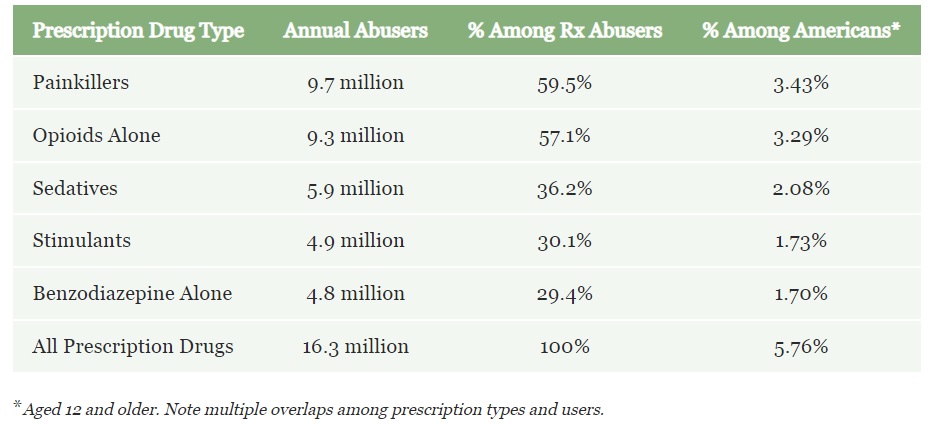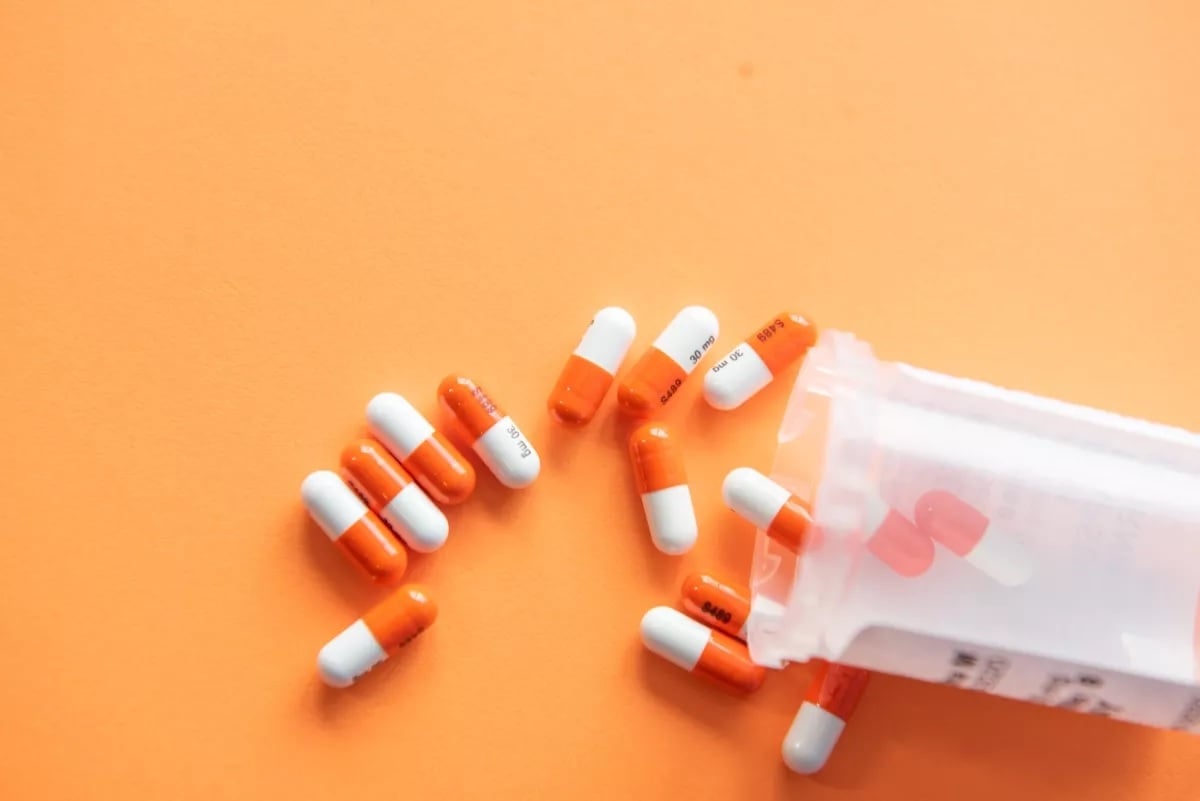Prescription drug abuse statistics are increasingly alarming. Prescription drug abuse (also known as PDA or prescription drug misuse) is defined by the Substance Abuse and Mental Health Services Administration [1] as “the intentional use of a medication without a prescription, in a way other than prescribed or for the experience or feeling it causes.” Let’s break this definition down into three parts to get a clearer understanding:
- The intentional use of a medication without a prescription - This can mean stealing medicine prescribed for someone else, or someone with a legitimate prescription sharing or giving the drugs to a friend. Individuals can also forge or alter prescriptions to get drugs they are not entitled to.
- In a way other than prescribed - This refers to taking medication that one has a prescription for but taking more than they are supposed to in one dose. Alternatively, taking medicine in a different way than one is supposed to, such as crushing up pills and snorting them or combining them with alcohol.
- For the experience or feeling it causes - This refers to using medicine for non-medicinal purposes (i.e., getting high).

Prescription drug abuse is considered to be an epidemic in the USA and other parts of the world and has been steadily increasing for the past 20 years. But why is prescription drug abuse on the rise? Read on to find out.
Why Are Prescription Drug Abuse Statistics on the Rise?
There’s many reasons a person may be drawn toward taking drugs in the first place. Mayo Clinic [2] lists the following reasons for both legal and illegal drug abuse: “to feel good or get high, to relax or relieve tension, to ease pain, to reduce appetite, to increase alertness, to experiment with mental effects of the substance, to maintain an addiction and prevent withdrawal, to be accepted by peers or to be social, to try to improve concentration and school or work performance.” The primary attraction toward drugs can vary depending on the age of the user.
Why do People Abuse Prescription Drugs?
Regarding why people take prescription drugs, there are several reasons:
● Perceived safety - Prescription drugs are safe to use, but only when used correctly. Many users fail to internalize the entirety of that statement, taking in only the first part of it. And because prescription drugs can be purchased over the counter and are dispensed by a medical professional, they are not regarded as harmful in the same way that illegal drugs are. The upshot of this is the dangerous belief that such drugs can be used in any manner without adverse consequences.
● Ease of availability - Illegal drugs such as cocaine and heroin are hard to get hold of, and users put themselves in the position of getting into trouble with the law. Prescription drugs, as mentioned above, can be obtained over the counter and are also more inexpensive. An increase in prescription drug abuse also can be seen to correlate with the number of prescriptions written. The United States consists of 5% of the world’s population yet consumes 75% of the world’s prescription drugs. This sets the context in which prescription drug abuse can occur.
Prescription Drug Statistics
- Among people aged 12 or older in 2021: 5.1% (or about 14.3 million people) reported misusing any prescription psychotherapeutic drug in the past 12 months. The most common type of drug misuse was prescription pain relievers followed by prescription tranquilizers or sedatives.
- Prescription drugs are the third-most abused illegal substance after marijuana (with 19.4% of the population using) and cocaine (with 15.9% usership).
- 52 million people in the United States over the age of 12 have used prescription drugs for non-medical reasons in their lifetime.
- Women are 11% more likely than men to be prescribed medication, but men are 22.9% more likely to misuse prescriptions.
- 62% of teenagers say they choose to abuse prescription drugs because they’re easy to find in parents’ medicine cabinets.
- 35% say they use prescriptions because they incorrectly believe prescriptions are “safer than illegal drugs”.
Signs of Prescription Drug Abuse
The following signs could indicate prescription drug abuse:
● Stealing, forging, or selling prescriptions is behavior that indicates that a person is using fraudulent means to obtain drugs. Addicts may use the prescriptions themselves or sell them to other people to help fund their habit.
● Taking doses beyond the recommended amount in quantity or frequency is a sign that someone has developed a tolerance to the drug.
● Doctor shopping refers to seeing multiple doctors simultaneously or changing from doctor to doctor in quick succession. Such behavior is a sign of an individual attempting to obtain multiple prescriptions, which suggests that the medication is being misused. Usually, addicts request early refills or “lose” prescriptions until a doctor grows suspicious and stops writing them.
Symptoms of Prescription Drug Abuse
When prescription drugs are used (or abused) in ways other than intended, there are various harmful side effects that the user can face in the short term. Drugs can also have harmful long-term effects on the user, as well as the fact that drug usage can develop into a more serious substance use disorder. The symptoms that a person would face from using a drug depend on which type of drug it is:
● Stimulants have side effects on energy and sleep, these may include paranoia, dangerously high body temperatures, an irregular heart rate, cardiovascular system failure, and fatal seizures.
● Opioids can cause drowsiness, nausea, and constipation. An excessive amount taken can result in life-threatening respiratory depression (reduced breathing), seizures, a weakened immune system, and an increased risk of heart disease.
● Depressants can cause slurred speech, shallow breathing, fatigue, disorientation, lack of coordination, decreased heart rate, and seizures upon withdrawal from chronic use.
The risks associated with prescription drug abuse vary depending on the type of drugs that are abused, as well as the amount taken.
Facts About Prescription Drug Abuse
The CDC [3] reports that prescription opioids were involved in nearly 24% of all opioid overdose deaths in 2020, a 16% increase in prescription opioid-involved deaths from 2019 to 2020. In addition, the National Institute on Drug Abuse [4] reports that in 2021 only 10.3 percent of people with past-year substance use disorder received treatment. The reasons why there is such a large mismatch between those involved with prescription drug abuse and those receiving treatment for it are varied. Users might not realize they are abusing prescription drugs, as among addicts, only 253,100 or 12.7% acknowledge their addiction [5]. They might also not understand the risks involved in taking prescription drugs, or feel powerless to stop their growing habit. They may want to receive help for their addiction but be unaware that professional assistance is available and how to access it.
You Don’t Need to Become One of the Prescription Drug Statistics
The support of a trained professional can help lower prescription drug abuse statistics and allow users to pull the breaks and prevent their addiction from escalating and becoming more severe.
If you are struggling with drug addiction or know someone who is, you already know that it can feel lonely and isolating. At Avenues Recovery, we are here for you and are ready to help you in your journey to recovery. We have a non-judgmental environment and proven experience in equipping people with the tools they need to turn their lives around. Contact us today to hear more about the detox and treatment programs we offer and the multiple services we provide.
Sources
[2] www.samhsa.gov
[3] cdc.gov
[4] nida.nih.gov



